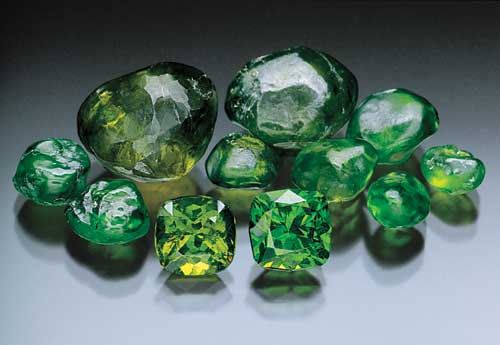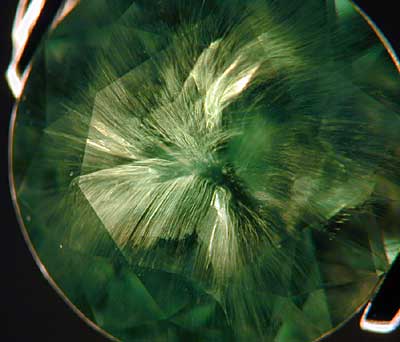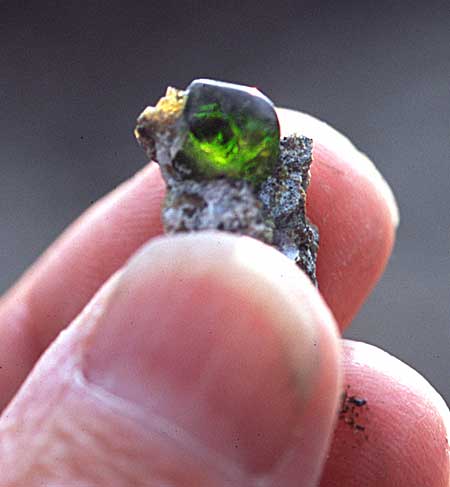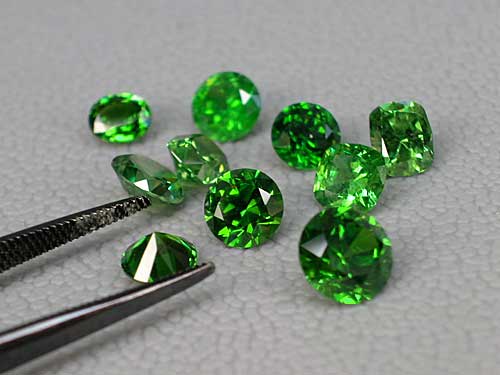
The Gem Spectrum is Pala International’s
free newsletter. Edited by Pala’s own Gabrièl Mattice,
it is filled with interesting articles on various aspects of gems
and minerals.
 We
distribute The Gem Spectrum free within
the United States to members of the gem and
jewelry trades. If
you would like to be added to our mailing
list, please contact
us. We
distribute The Gem Spectrum free within
the United States to members of the gem and
jewelry trades. If
you would like to be added to our mailing
list, please contact
us.

The Reds have the Greens
When the first Russian stuck his
hand into the icy waters of the Ural Mountains’ Bobrovka River
and pulled out a handful of shiny green pebbles, little did he know
that he would be triggering an entirely new movement in jewelry. Originally
thought to be peridot, the gem proved to be green andradite garnet,
and was dubbed “demantoid” after its diamond-like properties.
Before long, the workshops of Carl Fabergé were crafting stunning
pavé pieces for the Czars. Even New York’s Tiffany had its
chief gemologist, George F. Kunz, off in Russia buying all the fiery
green gems he could get hold of.
Then,
just as quickly as it appeared, it vanished.
Overnight, the Bolshevik revolution turned
Russia upside down, and that included the country’s
gem trade. The Reds had no need for bourgeois
luxuries such as gems. Thus the brilliant green
pebbles lay dormant in the swamps and marshes,
waiting patiently for a new suitor.
It
took the late-1980’s fall of the Soviet
Union to shake more demantoid loose from the
Ural soil. With communism gone, the former
Reds found green to be very much to their liking.
Once again, demantoid emerged onto the world
gem market. Like reconnecting with a long-lost
lover, buyers were smitten again, and quickly
rekindled the passion for these Ural pearls.
In
the 1990’s, Pala International’s
William Larson worked closely with the Russians
at several mining areas, but even with modern
mining methods, demantoids remained elusive.
This lady was definitely playing hard-to-get.
That
changed in the summer of 2002. When prospectors
digging at the old Kladovka mine uncovered
a brand-spanking new vein, Larson received
a frantic call from his Russian partner, Nicolai
Kouznetsov. Nicolai pleaded with Larson to
get on the next plane over to Russia: “Come
now! I’ve got something here even better
than caviar…”
To
a caviar lover like Larson, that was pure catnip.
Just forty-eight hours later, he walked into
an Ekaterinburg sorting room and was stunned
by what he saw – a gemologist sat behind
a giant green mountain. Over 20 kg of
demantoid – more than the world had seen
since the time of the Czars – was spread
out for viewing. Larson could say only one
thing: “Great googly moogly! The Reds
have the greens.”

A Visit to Russia’s Demantoid Mines
by William Larson
It’s late August, 2002, and
I’m exhausted, flying Aeroflot from Los Angeles to Moscow and
then a domestic jet to Ekaterinburg, jumping-off point for the Ural
Mountain gem mines. Yes I’m tired, but – damn the torpedoes – somebody
has to do it. Why, you ask? Because the Reds have just dug up what
promises to be one of biggest finds of green in a century. Green as
in demantoid garnet, imperial gem of Fabergé and the Czars.
After
arrival, Vadim, the mine manager, meets us
and we drive out to the mines. In the Urals,
the mining season is short – just three
to four months – and only in the last
two weeks has the insect population come down
to bearable. It was at the Kladovka site that
demantoid was first found last century. Indeed,
researching that historic discovery is what
led Vadim and his team here.
Exploration started in May, but by July, they were on the verge of giving
up. Then, Mother Russia threw her sons a little treasure. Workers exposed
a vein and before long, green Ural pearls were being unearthed in unheard-of
quantities.
In
one vein, the green garnets have formed in
crystals and aggregates. The best pieces are
isolated in lines of nodules, glistening like
green, polished tears. These are up to a quarter
inch in diameter.
Above
the pit, pea-sized pieces of demantoid are
scattered across a piece of canvas in a spectacular
display of newly dug treasure. We marvel at
the scene, turning beautiful, crystal-clean
demantoids in our fingers. The likes of this
have hardly been seen since the time of the
Czars.
A
few of the rocks are broken up, revealing nodules
of an extraordinary green color. As the last
sunlight fades, we retire to camp, where a
barbecue has already begun. We take several
fine demantoid samples back, and display them
like hunting trophies on the dinner table.
That
evening, over a toast, our Russian friends
invite us to return again. As Nicolai raises
his glass, he winks at me and says: “I
love this business. We travel far and wide
in search of these charms of nature. And in
doing so, we are exposed to the charms of people
from opposite sides of the globe. Here’s
to our business…” We raise our
glasses once more…
Yes,
I will definitely be back for more. All in
all, it is one of my most memorable days in
prospecting.
|
Palagems.com Demantoid
Garnet Buying Guide
By Richard
W. Hughes
Introduction/Name. Demantoid
is the name given to the rich green variety of andradite garnet.
The gem was first discovered in Russia and the name is derived
from its diamond-like adamantine luster.
Color. While
the color of demantoid never equals that of the finest emerald,
an emerald-green is the ideal. The color should be as intense
as possible, without being overly dark or yellowish green.
The color of demantoid is believed to be due to chromium. It
should be noted that demantoid’s fire is best seen in
the lighter, less saturate gems. Thus the color preference
is a matter of individual taste. Some people will choose an
intense body color and less fire, while others prefer a lighter
body color and more fire.
Lighting. Demantoid
garnet generally looks best under daylight. Incandescent light
makes it appear slightly more yellowish green. Because of its
high dispersion, demantoid looks great in the same type of
lighting as diamond, i.e., multi-point (as opposed to diffuse)
lighting.
Clarity. In
terms of clarity, demantoid is relatively clean. Thus when
buying one should expect eye-clean or near-eye-clean stones.
Demantoids often contain radiating needle inclusions that are
termed “horsetails.”
Cut. In
the market, demantoids are found mainly as round brilliant
or cushion cuts. Cabochon-cut demantoids are not often seen.
Prices. Demantoid
is among the most expensive of all garnets, with prices similar
to those fetched by fine tsavorite (the other green garnet).
But like all gem materials, low-quality (i.e., non-gem quality)
pieces may be available for a few dollars per carat. Such stones
are generally not clean enough to facet. Prices for demantoid
vary greatly according to size and quality. At the top retail
end, they may reach as much as US$10,000 per carat.
Stone Sizes. Demantoid
is rare in faceted stones above 2 cts. Fine demantoids above
5 carats can be considered world-class pieces. Most stones
tend to be less than 1 ct.
Sources. The
original locality for demantoid was in Russia’s Ural
Mountains. Today, deposits of lesser material exist in Iran,
Italy and Namibia, but the Russian material remains the standard
by which the gem is judged.
Enhancements. Some
demantoid garnet is heat-treated to improve the color. The
resulting stones are stable under normal wearing conditions.
Imitations. Demantoid
garnet has never been synthesized, but a number of imitations
exist. These include green glass and green YAG.
Properties of Demantoid Garnet
| |
Demantoid Garnet (a variety
of andradite garnet) |
| Composition |
Ca3Fe2(SiO4)3 |
| Hardness (Mohs) |
6.5 to 7 |
| Specific Gravity |
3.84 |
| Refractive Index |
1.888; Singly refractive |
| Crystal System |
Cubic |
| Colors |
Light to deep green |
| Pleochroism |
None |
| Dispersion |
0.057; this is among the highest
of all gems, even higher than diamond |
| Phenomena |
None |
| Handling |
Ultrasonic: generally safe,
but risky if the gem contains liquid inclusions
Steamer: not safe
The best way to care for demantoid garnet is to clean it with
warm, soapy water. Avoid exposing it to heat or acids. |
| Enhancements |
Some demantoid is heat treated
to improve the color |
| Synthetic available? |
No |
Further reading
For
more on Russia’s demantoid
mines, see Gabrièl Mattice’s Gem
Spectrum Newsletter, Vol. 4,
No. 1 |
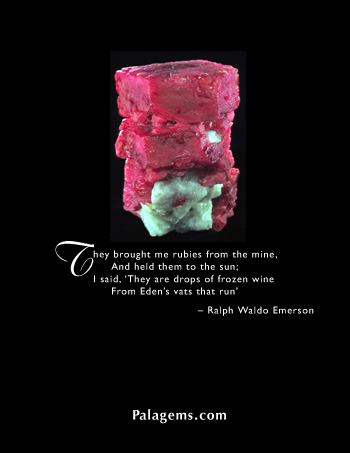 |
Big
Mama’s in the House
One of the most extraordinary ruby specimens ever to emerge
from Burma’s fabled Mogok Stone Tract was recently acquired
by Pala International. Pictured at left, this crystal weighs
an incredible 10,100 carats. We have affectionately name it “Big
Mama.”
In the world of rubies, Mogok has no peer, with the finest
pigeon’s blood reds so rare that, above two carats, they
easily surpass diamond in price. Crystals of this quality are
equally rare. Big Mama is available for viewing by appointment.
|
|

|

